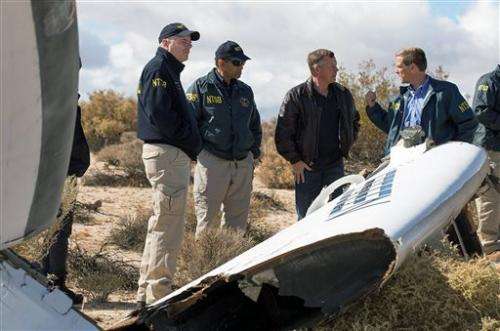Pilot's survival hailed as miracle, but not unique

As the doomed flight rocketed past the speed of sound some 8 miles (13 kilometers) high and then shattered seconds later, the odds of survival were slim. Remarkably, as sections of the cockpit, fuselage, a wing and motor of the SpaceShipTwo rained down over the Mojave Desert in California and pieces of the lightweight craft tiny enough to travel 35 miles (56 kilometers) were picked up by the winds, a single parachute was seen in the sky.
Pilot Peter Siebold was alive and drifting to safety.
"It's no minor miracle that he did survive and survive in relatively good shape," Virgin Galactic chief executive George Whitesides said this week.
How Siebold, 43, survived the fall from extreme altitude while co-pilot Mike Alsbury, 39, perished a week ago is not yet clear, but Siebold is not the first to live through such a harrowing ordeal.
Bill Weaver, 85, has been telling a similar story for decades.
The former Lockheed test pilot was torn from the seat of an SR-71 Blackbird at 78,800 feet (24,000 meters) above New Mexico on Jan. 25, 1966. The plane was going faster than 2,400 mph (3,900 kph)—more than triple the speed of sound.
As Weaver banked into a turn, a malfunction caused one engine to lose thrust. He quickly lost control of the jet and knew he was in trouble as the plane began to pitch and break up. He didn't have time to be scared.
"I knew we were going to just be along for the ride," he said.
Weaver tried to radio to the reconnaissance and navigations officer in the back seat that there was no way to safely bail out at that altitude and speed, so they should stick with the plane and eject when it got lower. But the severe gravitational forces made his speech unintelligible and then he blacked out.
The whole event to that point took two to three seconds.
When Weaver regained consciousness, his first thought was that he was dreaming. With the face plate on his helmet iced over from temperatures as cold as minus 55 Fahrenheit (-48.33 Celsius), he could only see a hazy white light and in a detached sense of euphoria, he thought he was dead. He was relieved when he realized he was alive and plunging toward Earth.
"I had no idea how I got out of the airplane," he said. "I had no idea how long I had been free falling. Had no idea how high I was or low I was."
How Siebold got out of SpaceShipTwo is also unknown, according to National Transportation Safety Board Acting Chairman Christopher Hart, who said the pilot hadn't been interviewed because he's recovering from major injuries.
Initial findings show the Virgin Galactic plane designed to take tourists for $250,000 joyrides beyond the edge of Earth's atmosphere, broke apart after the craft's re-entry braking system prematurely activated, Hart said.
Alsbury had unlocked the system, known as the feathering system, earlier than called for. A second lever must be moved to engage the system, but it deployed on its own for some unknown reason. The craft broke up a few seconds later.
SpaceShipTwo did not have ejection seats, but there was an evacuation procedure.
Typically, the pilot would stay with the controls and the co-pilot would depressurize the cabin and then they would both unbuckle and bail out with their parachutes, said Brian Binnie, a former test pilot for Scaled Composites, which designed and built the craft for Virgin.
But an aircraft that violently tears apart around you isn't something you prepare for.
"All bets are off. Now you're back to DNA. What do you think is your next best move? If you've been knocked out or unconscious you don't have a next best move," said Binnie, who flew five times in the spaceship and knew the pilots. "Peter, whatever he did, in my mind, he had a patron saint of a particular strength or influence."
The biggest initial challenge in surviving such a disaster would a windblast of about 500 mph (800 kph) that could blow off eyelids, tear off limbs and snap vertebrae if Siebold was thrown from the craft, said Dr. John Ogle, an Air Force flight surgeon who has investigated plane ejections and crashes.
Ogle suspects Siebold probably stayed with some of the wreckage, such as his seat, which would have slowed his fall. Siebold would have faced the triple threat of lack of oxygen, extreme cold and intense air pressure as he fell at a rate of about 300 mph (500 kph), he said.
© 2014 The Associated Press. All rights reserved.


















